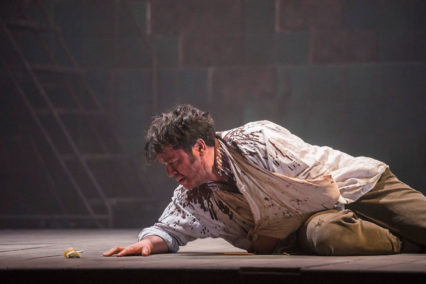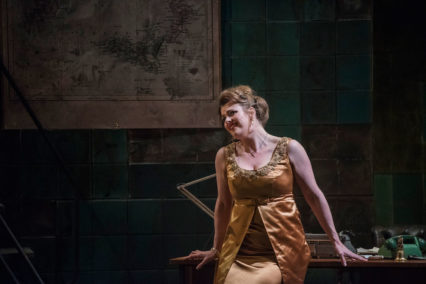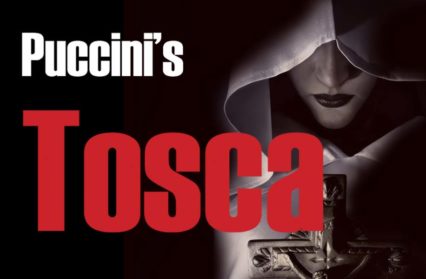Nigel Jarrett reviews Mid Wales Opera’s production of Puccini’s masterpiece, Tosca, at the Riverfront, Newport.
Comments on small-scale touring opera have at some stage to stop moaning about its flaws and appreciate what it can do despite them. It does intimacy very well, almost by definition. In large opera houses and theatres, the gulf of the orchestra pit separates the audience from the stage on which singers bellow almightily into the void; in smaller ones hosting chamber-style productions of the sort put on by Mid Wales Opera, almost everything is restricted, from the orchestra (and thus its sink-hole) to the spatial concepts. The audience is a tad closer to everything and therefore better able in many cases to be moved by the human interactions.
The problem in Puccini’s Tosca and many other operas is that the individuals are consorting against the backdrop of huge and real historical events; in Tosca‘s case, the Napoleonic Wars and the turmoil in Europe resulting from the French Revolution’s complicated effects on Italy. In any production of it, grand or minuscule, this has to be imagined; but the strain of imagining can be lessened in a commodious house by the sets and the vaults into which the descriptive musical sounds will reverberate, as if carrying all the way to the battlefields. Not so, or not as much, in more modest places.
But there’s another issue in director Richard Studer’s production for MWO: the action has been shunted forwards from 1800 to some undefined post-quill, pre-computer age in which tyranny reigns, as it often does. It matters not that, in the original libretto and as the opera opens, Italy is believed to have won a battle against the French, Angelotti (Joseph Padfield) is a political fugitive desiring the Bonaparte ideal for his country, and that a fired cannon signals the escape from jail of such a subversive. For Studer, this is any old war – why not a modern one? – and these are its events and characteristics in common: suicide, murder, torture, personal hubris, and execution by firing squad, all playing their part in the thwarting of true love; or as true as a pair of Italian artistic types, the painter Cavaradossi (Charne Rochford) and the singer Tosca herself (Elin Pritchard), can manage.
 Amanda Holden’s English translation/interpretation of the libretto obscures some of the contemporary references, but Studer retains the cannon, In this performance – the final one of the tour – it was muffled and off-stage. He also mixes and matches costumes, the uniforms of police spooks Spoletta (Jonathan Cooke) and Sciarrone (Matthew Tilley) being Third Reich/Ruritanian and the prison garb of Angelotti and Cavaradossi off-the-shelf Robinson Crusoe. Studer scores ironically or perhaps unintentionally, however, in making an enforced economy of scale work as an interesting comment on what’s happening. Freed of their early 19th century trappings set in Rome, act one’s handsome Church of Sant’Andrea della Valle becomes the corner of a dingy chapel; act two’s palatial quarters of dastardly police chief Scarpia (Nicholas Folwell) in the Palazzo Farnese a cheerless office, albeit still with torture chamber en suite; and act three’s ramparts of the Castel Sant’Angelo, with its view of St. Peter’s, a high-walled back yard.
Amanda Holden’s English translation/interpretation of the libretto obscures some of the contemporary references, but Studer retains the cannon, In this performance – the final one of the tour – it was muffled and off-stage. He also mixes and matches costumes, the uniforms of police spooks Spoletta (Jonathan Cooke) and Sciarrone (Matthew Tilley) being Third Reich/Ruritanian and the prison garb of Angelotti and Cavaradossi off-the-shelf Robinson Crusoe. Studer scores ironically or perhaps unintentionally, however, in making an enforced economy of scale work as an interesting comment on what’s happening. Freed of their early 19th century trappings set in Rome, act one’s handsome Church of Sant’Andrea della Valle becomes the corner of a dingy chapel; act two’s palatial quarters of dastardly police chief Scarpia (Nicholas Folwell) in the Palazzo Farnese a cheerless office, albeit still with torture chamber en suite; and act three’s ramparts of the Castel Sant’Angelo, with its view of St. Peter’s, a high-walled back yard.
This descent into the unrelievedly drab takes Tosca with it. She’s not the woman who, released from her convent vows but still oscillating ‘twixt piety and earthly love, has become a diva, wowing audiences in Milan and Venice, but almost a jobbing songstress who nevertheless has made a recording, perhaps a demo-disc. In place of Tosca and the choir heard by Scarpia through his open window in act two, the villain himself plays the record on his gramophone, clearly an essential item in the office of a vicious top cop, together with a symbolic bird in a cage. Set designers do dreariness well – Dan Saggars’s lighting is almost perfunctory – though the high scaffolding ladder on which Cavaradossi is painting his giant picture of the Magdalene in act one and in act three functions as a connect between the top of the wall and the back yard, now revealed as a killing-ground, is clumpily out of place in Scarpia’s HQ, unless he has the decorators in and they’re on a day off. One would miss the populous church scenes – just the one young chorister (Alys Mererid Roberts) to bother the Sacristan (Emyr Wyn Jones) – were it not for the MWO’s excellent community choir representing the worshippers, some holding up pictures of their ‘departed’ without attracting the brutal attentions of Scarpia and his henchmen.
This displacement of mise-en-scène and its resulting alteration of tone is fine, and fits the requirements of closer contact between audience and stage. It’s what this kind of touring opera does best, given economies of a different scale. Scarpia, too, is here downgraded in the scheme of things, from the character before whom all Rome quakes to one before whom anonymous recalcitrants might or might not quake in their turn. Common to all chamber-style productions, of course, is the score. For MWO it is always neatly reduced and performed, in this case by musical director and conductor Jonathan Lyness for twelve musicians of Ensemble Cymru, the resident band at Bangor University and Venue Cymru in Llandudno. It cannot make the full orchestral noise Puccini insisted on for Tosca‘s moments of terror (Scarpia’s entrance and subsequent interpolations of his motif), religious celebration (the act one Te Deum), or even the more ardent love interest (Tosca and Cavaradossi in their act one duet); but it can comfortably urge the reflective arias on, as in Tosca’s ‘I have lived for art and love’ (Vissi d’arte, vissi d’amore), Cavaradossi’s ‘Strange harmony’ (Recondita armonia) and Scarpia’s ‘Venal my enemies call me’ (Già mi dicon venal). The outstanding example is ‘The stars are shining’ (E lucevan le stelle), Cavaradossi’s pre-execution song of remembered happiness, delivered by Rochford with strength and humanity, a telling combination at that stage of the drama. The cast, including young Roberts doubling as chorister and the act three Shepherd Boy, sings well and at full stretch throughout, even allowing for what might have been some end-of-tour gilding; the curtain-calls were jollified, rightly so, and included Julie Doyle, who signed the performance from the side of the stage. That said, Folwell’s Scarpia, despite a forceful and unwavering projection, was not obviously scary; maybe shadowy, downtable thugs aren’t, however much in charge.
 Act two could have done with more febrile choreographing of the two principals, and Tosca’s overt revelation behind her back of the knife with which she’s about to despatch Scarpia – Don’t look now, but she’s going to kill him!! – was as melodramatic as her placing of the lit candles about the head of his prone body was absurd. It’s one of the opera’s great emblems; but why there should have been candles alight in a room from whose ceiling hung about eight large lamps was not explained. The biggest disappointment, if that’s what it was, came in the final seconds, when Tosca, heading for self-destruction, didn’t jump off the ‘battlements’ but walked off stage left to do so unseen. Having decided it was just a wall bordering a derelict back yard, we could have believed that she was going anywhere. Amusingly, the programme’s synopsis in English ended mid-sentence at the point where it should have confirmed her suicide. Tosca’s shout of ‘We’ll meet before god’ (O, Scarpia, avanti a Dio) thus lost its immediacy. We wuz, as they say, robbed – of opera’s most famous ending. (The programme also stated incorrectly that the first performance of Tosca was at La Scala, Milan; it was at the Teatro Costanzi in Rome.)
Act two could have done with more febrile choreographing of the two principals, and Tosca’s overt revelation behind her back of the knife with which she’s about to despatch Scarpia – Don’t look now, but she’s going to kill him!! – was as melodramatic as her placing of the lit candles about the head of his prone body was absurd. It’s one of the opera’s great emblems; but why there should have been candles alight in a room from whose ceiling hung about eight large lamps was not explained. The biggest disappointment, if that’s what it was, came in the final seconds, when Tosca, heading for self-destruction, didn’t jump off the ‘battlements’ but walked off stage left to do so unseen. Having decided it was just a wall bordering a derelict back yard, we could have believed that she was going anywhere. Amusingly, the programme’s synopsis in English ended mid-sentence at the point where it should have confirmed her suicide. Tosca’s shout of ‘We’ll meet before god’ (O, Scarpia, avanti a Dio) thus lost its immediacy. We wuz, as they say, robbed – of opera’s most famous ending. (The programme also stated incorrectly that the first performance of Tosca was at La Scala, Milan; it was at the Teatro Costanzi in Rome.)
It’s impossible not to admire the pluck and skill with which Mid Wales Opera brings productions of class to places and audiences away from opera’s active centres. It’s a team, and long may it regale us with its teamwork. A new one-act comic opera by Lyness and Studer, Mrs Peachum’s Guide to Love & Marriage, is due from the company this autumn. It’s based on John Gay’s The Beggar’s Opera.
You might also like…
David Truslove was at London’s Coliseum for the English National Opera’s (ENO) revival of Anthony Minghella’s Olivier Award-winning production; Giacomo Puccini’s Madam Butterfly.
Nigel Jarrett is a former newspaperman and a double prizewinner: the Rhys Davies Award for short fiction and, in 2016, the inaugural Templar Shorts award. His first story collection, Funderland, published by Parthian, was praised by the Guardian, the Independent, the Times and many others, and was longlisted for the Edge Hill Prize. His debut poetry collection, Miners At The Quarry Pool, also from Parthian, was described by Agenda poetry magazine as ‘a virtuoso performance’. Jarrett’s first novel, Slowly Burning (GG Books) was published in 2016, as was his second story collection, Who Killed Emil Kreisler? (Cultured Llama Publishing). Templar is about to publish his three-story pamphlet, A Gloucester Trilogy. Based in Monmouthshire, Jarrett also writes for Jazz Journal, Acumen poetry magazine, and several others.



 Enjoyed this article? Support our writers directly by buying them a coffee and clicking this link.
Enjoyed this article? Support our writers directly by buying them a coffee and clicking this link.







